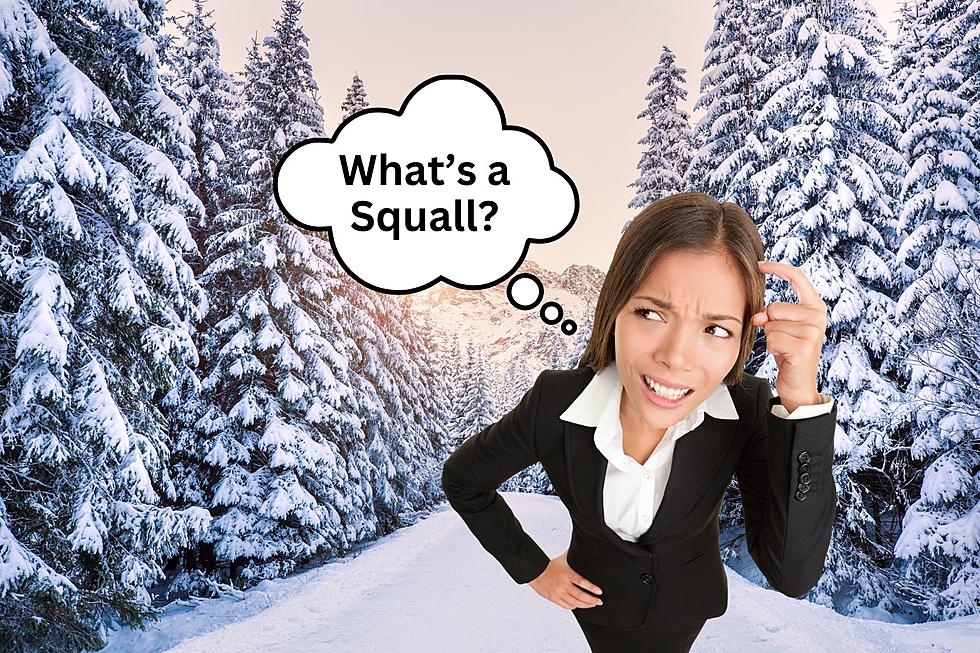
Demystifying Winter Weather Terms: You Need To Know In Washington State
Now, terms used in Weather forecasts can be very obvious and some, not so much. Like I had no idea what a "Squall" was with a recent weather warning I got from the weather service. So let's have a refresher!
Winter Weather Terms to know in WA:
Blizzard -
"A sustained wind or frequent gusts to 35 mph or greater, and considerable falling and/or blowing snow, for example, reducing visibilities frequently to less than 1/4 mile. These conditions are expected for a period of 3 hours or more." (Source)
Blowing Snow -
No, it's not when you have to go blow the snow from your driveway.
"Wind-driven snow that reduces surface visibility to less than seven miles." (Source)
Drifting Snow -
"An uneven distribution of snowfall caused by surface wind." (source)
Drizzle -
Golly, every time I hear or see the word "drizzle," it makes me want Carmel drizzle on top of a coffee...
"Drizzle is liquid precipitation that reaches the surface in the form of drops that are less than 0.5 millimeters in diameter." (Source)
Freezing Drizzle -
Caramel Drizzle frozen on top of a Frappuccino? Yes please?
"Freezing Drizzle is liquid precipitation that reaches the surface in the form of drops that are less than 0.5 millimeters in diameter. The drops then freeze on the earth's surface." (source)
Freezing Fog -
"Freezing fog is a fog composed of supercooled water drops. These drops freeze just after they wet the earth's surface." (Source)
Freezing Rain -
"Freezing Rain is liquid precipitation that reaches the surface in the form of drops that are greater than 0.5 millimeters in diameter. The drops then freeze on the earth's surface." (Source)
Graupel -
I had never heard this term!
"Graupel forms in the same way as hail except the diameter is less than 5 millimeters. It usually grows by soft hail processes." (Source)
Hail -
Easily could have summed these guys up to, "Balls That are frozen and hurt if you get impaled by one." But noooo
"Hail is dense precipitation ice that is that least 5 millimeters in diameter. It forms due to ice crystals and supercooled water that freeze or stick to the embryo hail stone. Soft hail is more white and less dense since it has air bubbles. Soft hail occurs when hail grows at a temperature below freezing by ice crystals and small supercooled water and cloud droplets merging onto the hail. Hard hail occurs when liquid water drops freeze on the outer edges of the hailstone after the outer edge is above freezing. The freezing of supercooled water releases latent heat and this can result in the outer edge of the hail stone warming above freezing. Then the water refreezes creating solid ice. Hail will commonly have soft ice and hard ice layers when it is sliced open." (Source)
Ice Crystals -
"Also called diamond dust. They are small ice crystals that float with the wind." (Source)
Mixed Precipitation -
"The combination of two or more winter precipitation types occurring at the same time or over a period of time at the same place." (Source)
Rain -
Pretty self-explanatory but here ya go anyway...
"Rain is liquid precipitation that reaches the surface in the form of drops that are greater than 0.5 millimeters in diameter. The intensity of rain is determined by the accumulation over a given time. Categories of rain are light, moderate and heavy." (Source)
Sleet / Ice Pellets -
"Sleet (Ice Pellets) are frozen raindrops that strike the earth's surface. In a sleet situation the precipitation aloft when it is first generated will be snow. The snow falls through a layer that is a little above freezing and the snow partially melts. If the snow completely melts it will be more likely to reach the earth's surface as supercooled water instead of sleet. If the snow partially melts there will still be ice within the falling drop for water to freeze on when the drop falls into a subfreezing layer. The lowest layer of the troposphere will be below freezing in a sleet situation and deep enough to freeze drops completely. The lower boundary layer can be above freezing, and sleet occur if the sleet does not have time to melt before reaching the surface." - Source
Snow -
Again, we know but maybe they will throw us a curve ball and say, "When lava...." No? Not at all? Cool, cool, cool.
"Snow is an aggregate of ice crystals that form into flakes. Snow forms at temperatures below freezing. For snow to reach the earth's surface the entire temperature profile in the troposphere needs to be at or below freezing. It can be slightly above freezing in some layers if the layer is not warm or deep enough the melt the snowflakes much. The intensity of snow is determined by the accumulation over a given time. Categories of snow are light, moderate and heavy." (Source)
Snow Grains -
"Snow grains are small grains of ice. They do not produce much accumulation and are the solid equivalent to drizzle." - (Source)
Snow Pellets -
"A snow pellet is precipitation that grows by supercooled water accreting on ice crystals or snow flakes. Snow pellets can also occur when a snowflake melts about half way then refreezes as it falls. Snow pellets have characteristics of hail, sleet and snow. With sleet (ice pellets), the snowflake almost completely melts before refreezing thus sleet has a hard ice appearance. Soft hail grows in the same way snow pellets can grow and that is ice crystals and supercooled water accreting on the surface. Snow pellets will crush and break apart when pressed. They can bounce off objects like sleet does. Snow pellets have a whiter appearance than sleet. Snow pellets have small air pockets embedded within their structure and have visual remnants of ice crystals unlike sleet. Snow pellets are typically a couple to several millimeters in size." - Source
Snow Squall -
"Snow squalls, often associated with strong cold fronts, are a key wintertime weather hazard. They move in and out quickly, and typically last less than an hour. The sudden white-out conditions combined with falling temperatures produce icy roads in just a few minutes. Squalls can occur where there is no large-scale winter storm in progress and might only produce minor accumulations. Snow squalls can cause localized extreme impacts to the traveling public and to commerce for brief periods of time. Unfortunately, there is a long history of deadly traffic accidents associated with snow squalls. Although snow accumulations are typically an inch or less, the added combination of gusty winds, falling temperatures and quick reductions in visibility can cause extremely dangerous conditions for motorists." - Source
Now get out there, know the weather and drive safe! Or stay home where it's warm :)
Washington Winter Emergency Car Kit
Gallery Credit: AJ Brewster
5 Magical Winter Towns to Explore in Washington and Oregon That Aren't Leavenworth
Gallery Credit: Rik Mikals
6 Washington Cabins for the Perfect Winter Soak
